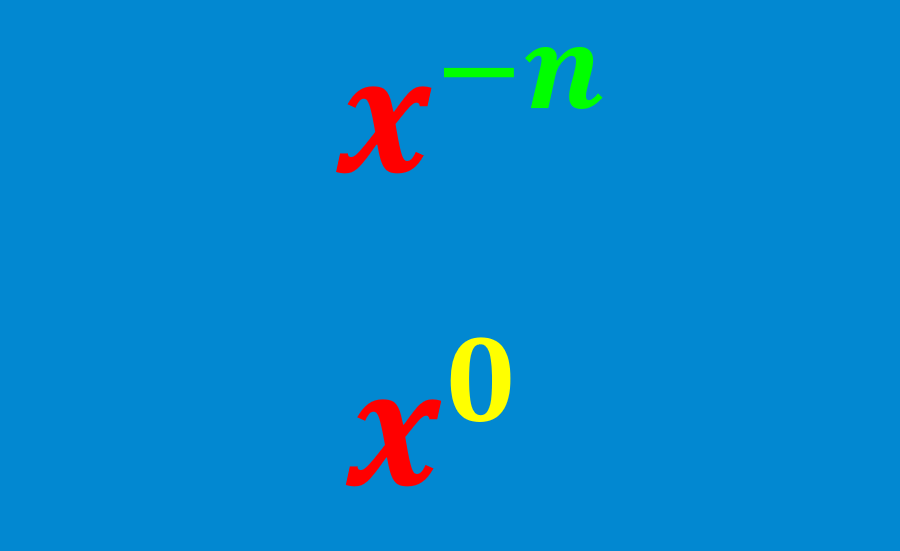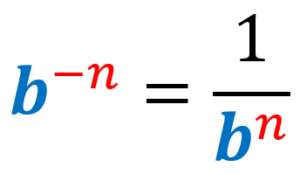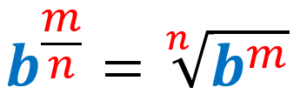To solve negative exponents with fractions, we have to use both the negative exponents’ rule and the fractional exponent’s rule. We will look at the process that can be used to simplify expressions that have negative exponents with fractions along with various exercises to improve understanding.
ALGEBRA

Relevant for…
Learning to simplify expressions that have negative exponents in fractions.
ALGEBRA

Relevant for…
Learning to simplify expressions that have negative exponents in fractions.
How are negative exponents calculated?
To calculate powers of negative exponents, we have to remember that a negative exponent simply means that the base is on the opposite side of the fraction, therefore, we need to flip the fraction so that the base is on the other side.
The negative exponents’ rule tells us that:

EXAMPLE 1
Simplify to the expression $latex {{3}^{-2}}$.
Solution: We know that the negative exponent means that the base belongs to the other side of the fraction. But we see that there is no fraction line. However, we know that this can be written as a fraction with denominator 1.
Therefore, we start by converting the expression to a fraction in the way that all expressions can be converted to fractions: by putting it over the 1. Therefore, we have the following:
$latex {{3}^{{-2}}}=\frac{{{{3}^{{-2}}}}}{1}=\frac{1}{{{{3}^{2}}}}=\frac{1}{9}$
EXAMPLE 2
Write a $latex x^{-3}$ using only positive exponents.
Solution: Again, we know that we have to swap the base to the other side of the fraction and change the exponent from negative to positive. We form a fraction by putting the expression over 1.
Thus, we start by converting the expression to a fraction where the denominator is 1 and then we simplify. Therefore, we have the following:
$latex {{x}^{{-3}}}=\frac{{{{x}^{{-3}}}}}{1}=\frac{1}{{{{x}^{3}}}}$
How to solve a fraction with negative exponents?
Fractions with negative exponents in the numerator can be simplified by swapping the negative exponent terms from the numerator to the denominator and making them positive.
Fractions with negative exponents in the denominator can be simplified by swapping the terms with negative exponents from the denominator to the numerator and making them positive.
Then, we have $latex {{x}^{- n}}=\frac{1}{{{x}^n}}$ and $latex \frac{1}{{{x}^{- n}}}={{x}^n}$. This means that a negative exponent is equal to the reciprocal of a positive exponent.
EXAMPLE 1
- Simplify the fraction $latex \frac{{{{4}^{{-2}}}}}{{{{8}^{{-2}}}}}$.
Solution: We can apply the negative exponent rule separately to the numerator and denominator and then simplify the resulting expression. Therefore, we have:
$latex \frac{{{{4}^{{-2}}}}}{{{{8}^{{-2}}}}}=\frac{1}{{{{4}^{2}}}}\times \frac{{{{8}^{2}}}}{1}$
$latex =\frac{{{{8}^{{2}}}}}{{{{4}^{{2}}}}}$
$latex =\frac{64}{16}$
$latex =4$
We have that $latex \frac{{{{4}^{{-2}}}}}{{{{8}^{{-2}}}}}$ is equivalent to 4.
EXAMPLE 2
- Simplify the fraction $latex \frac{{3{{x}^{{-2}}}y}}{{xy}}$.
Solution: In this case, only the expression $latex {{{x}^{{-2}}}}$ has a negative exponent. Therefore, we change that expression from the numerator to the denominator and make it positive:
$latex \frac{{3{{x}^{{-2}}}y}}{{xy}}=\frac{{3y}}{{{{x}^{2}}\left( {xy} \right)}}$
$latex =\frac{{3y}}{{{{x}^{3}}y}}$
Now, we cancel the like terms in both the numerator and the denominator:
$latex \frac{{3y}}{{{{x}^{3}}y}}=\frac{{3}}{{{{x}^{3}}}}$
How to solve negative exponents with fractions?
To solve negative exponents with fractions, we need to remember the rule for fractional exponents, which allows us to relate powers and roots:

Therefore, when we have negative exponents with fractions, we start by applying the negative exponents’ rule and then we apply the fractional exponents rule.
EXAMPLE 1
- Simplify the fraction $latex \frac{{{{4}^{{-\frac{1}{2}}}}}}{{{{6}^{{-2}}}}}$.
Solution: In the numerator we have a negative fractional exponent and in the denominator we have a negative exponent. Therefore, we start by applying the rule of negative exponents:
$latex \frac{{{{4}^{{-\frac{1}{2}}}}}}{{{{6}^{{-2}}}}}=\frac{{{{6}^{2}}}}{{{{4}^{{\frac{1}{2}}}}}}$
Now we have positive exponents in both the numerator and denominator, but we have a fractional exponent in the denominator, so we apply the fractional exponents rule there:
$latex =\frac{{{{6}^{2}}}}{{\sqrt{4}}}$
Now, we apply the exponents and simplify:
$latex =\frac{{36}}{2}$
$latex =18$
EXAMPLE 2
- Simplify the expression $$\frac{{{{x}^{{-\frac{3}{2}}}}}}{{{{{16}}^{{-\frac{1}{4}}}}{{y}^{{-\frac{1}{2}}}}}}$$
Solution: All the exponents are negative, so we start by applying the negative exponents rule:
$$\frac{{{{x}^{{-\frac{3}{2}}}}}}{{{{{16}}^{{-\frac{1}{4}}}}{{y}^{{-\frac{1}{2}}}}}}=\frac{{{{{16}}^{{\frac{1}{4}}}}{{y}^{{\frac{1}{2}}}}}}{{{{x}^{{\frac{3}{2}}}}}}$$
Now, we have positive exponents in the numerator and in the denominator. We can apply the fractional exponent rule:
$latex =\frac{{\sqrt[4]{{16}}\sqrt{y}}}{{\sqrt{{{{x}^{3}}}}}}$
Finally, we simplify:
$latex =\frac{{2~\sqrt{y}}}{{\sqrt{{{{x}^{3}}}}}}$
Fractions with negative exponents examples with answers
EXAMPLE 1
- Simplify the expression $latex \frac{{{{x}^{2}}}}{{{{x}^{{-3}}}}}$.
Solution: This expression only has the denominator with a negative exponent. Therefore, we move the denominator to the numerator with a positive exponent :
$latex \frac{{{{x}^{2}}}}{{{{x}^{{-3}}}}}=\frac{{{{x}^{2}}{{x}^{3}}}}{1}$
Now, we only have positive exponents and we can apply the product of exponents rule to simplify:
$latex ={{x}^{{2+3}}}={{x}^{5}}$
EXAMPLE 2
- Simplify the expression $$\frac{{{{{25}}^{{-\frac{1}{2}}}}}}{{{{{16}}^{{-\frac{1}{4}}}}}}$$
Solution: In this case, we have fractional negative exponents. Therefore, we start by applying the rule of negative exponents to change from the numerator to the denominator and vice versa and change from negative to positive:
$latex \frac{{{{{25}}^{{-\frac{1}{2}}}}}}{{{{{16}}^{{-\frac{1}{4}}}}}}=\frac{{{{{16}}^{{\frac{1}{4}}}}}}{{{{{25}}^{{\frac{1}{2}}}}}}$
Now, we have positive exponents in both the numerator and the denominator. Thus, we can apply the rule of fractional exponents to form radicals:
$latex =\frac{{\sqrt[4]{{16}}}}{{\sqrt{{25}}}}$
Finally, we calculate the radicals:
$latex =\frac{2}{5}$
EXAMPLE 3
- Rewrite the expression $latex {{\left( {\frac{{{{x}^{{-3}}}}}{{{{y}^{{-2}}}}}} \right)}^{{-2}}}$ only using positive exponents.
Solution: We start by noting that we have a negative exponent outside the parentheses. This means that the numerator must be moved down and the denominator must be moved up. That is, we must flip the fraction that is inside the parentheses:
$latex {{\left( {\frac{{{{x}^{{-3}}}}}{{{{y}^{{-2}}}}}} \right)}^{{-2}}}={{\left( {\frac{{{{y}^{{-2}}}}}{{{{x}^{{-3}}}}}} \right)}^{2}}$
Now that we have a positive exponent, we use the power of a power rule to apply the exponent separately to the numerator and denominator:
$latex =\frac{{{{{\left( {{{y}^{{-2}}}} \right)}}^{2}}}}{{{{{\left( {{{x}^{{-3}}}} \right)}}^{2}}}}$
$latex =\frac{{{{y}^{{-4}}}}}{{{{x}^{{-6}}}}}$
Finally, we use the negative exponents rule again and flip the fraction:
$latex =\frac{{{{x}^{6}}}}{{{{y}^{4}}}}$
Try solving the following practice problems
See also
Interested in learning more about exponents? Take a look at these pages:



